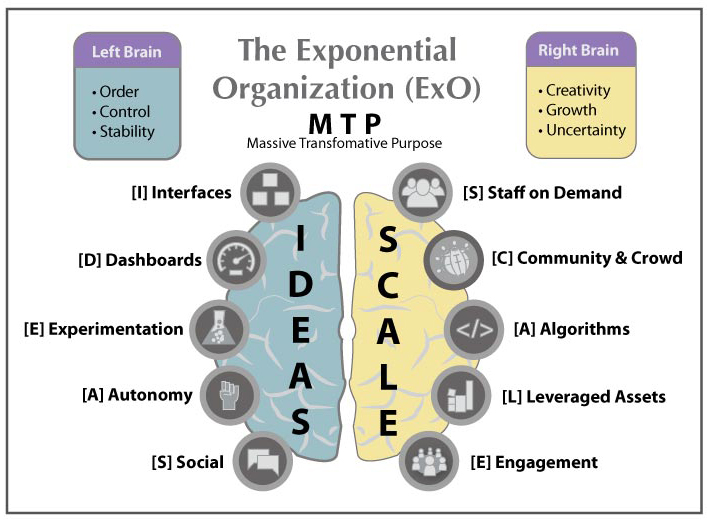The Exponential Organization (ExO)
The Exponential Organization (ExO)
The “Brain” you see pictured below is the brainchild of a Salim Ismail, the author of the book “Exponential Organizations: Why new organizations are ten times better, faster, and cheaper than yours (and what to do about it). This book describes how the velocity of technological change occurring today in the world is unprecedented. This fact has given rise to the “exponential entrepreneur” and “exponential organizations” (ExO’s). Salim Ismail is the Singularity University (SU) global ambassador and former head of innovation at Yahoo. Salim Ismail defines an exponential organization as one whose impact (or output) - because of its use of networks or automation and/or its leveraging of the crowd - is disproportionately large compared to its number of employees.
Contrast this to a linear organization - lots of employees and lots of physical processes and facilities. For all the twentieth century, exponential organizations did not exist and linear companies were protected from upstart intruders by sheer size. Those days are now gone. The folks at SU posit this observation in a rather creative way. Think of 20th century Fortune 500 companies as dinosaurs.

Think of exponential technology as the meteorite that took out the dinosaurs. And the animals that dominated from that point….the mammals...more optimal body type, had a neocortex which allowed for creative problem solving (the lizards did not) and were MUCH MORE NIMBLE...the exponential organizations (ExOs) are the mammals.
It doesn’t look like it, but the ExO model shown above is where people like Elon Musk and Reid Hoffman and Peter Thiel get a big chunk of their competitive advantage. It’s their secret sauce as it were, in addition to their obvious intellect. What Salim Ismail (along with Michael Malone and Yuri Van Geest) did was, in a sense, codify the “PayPal Mafia”.
|
"PayPal Mafia" is a term used to indicate a group of former PayPal employees and founders who have since founded and developed additional technology companies such as Tesla Motors, LinkedIn, Palantir Technologies, SpaceX, YouTube, Yelp, and Yamme, The PayPal Mafia is sometimes credited with inspiring the re-emergence of consumer-focused Internet companies after the dot-com bust of 2001. |
So not only is Silicon Valley exporting its exponential technology, it is exporting its organizational structure. Companies like Google, Amazon, Apple, Facebook apply these principles as well.
Because of the fast paced world of exponential technology, it has been predicted that in 10 years 40% of existing Fortune 500 Companies will no longer survive.9 Richard Foster of Yale University estimates that the average lifespan of an S&P 500 company has decreased from 67 years in the 1920s to 15 years today. Note that the venerable icon General Electric which has been included among the 30 companies that have made up the Dow Jones Industrial for the last 100 years….just got kicked out. And that Lifespan is going to get even shorter in the years to come as these giant corporations aren’t just forced to compete with, but are annihilated...seemingly overnight...by a new breed of companies that harnesses the power of exponential technologies, from groupware and data mining to synthetic biology and robotics. And as the rise of Google portents, the founders of those new companies will become the leaders of the world’s economy for the foreseeable future.
Leveraged by new generations of technology that, thanks to Moore’s Law, have emerged every few years, the infrastructure is now in place for many industries to move to this framework—and they will, not only because it confers enormous competitive advantage, but also because it rewards first movers.
